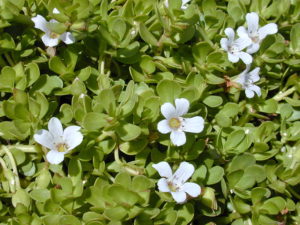
Bacopa monnieri is known in India and sub-tropical regions for its medicinal value. David Winston, in Adaptogens Herbs for Strength, Stamina and Stress Relief (his book was reviewed earlier on this blog, classifies the herb with nootropics, those plant substances that support the tonic plants of benefit to humans. He says that nervines, anticonvulsants and mild antioxidants work to assuage ischemic disease and seizure activity.
Bacopa monnieri is just one species of Bacopa, the only species recognized as having medicinal value. (The garden variety—plants with decorative blooms or leaves, shapes, etc.—of Bacopa species includes more than 150 named species and all but one are ornamental, not medicinal.) B. monnieri can be helpful to the central nervous system and brain functions where epilepsy, asthma, problems with memory, trauma, dementia, or anxiety are present.
David Winston, and authors Andrew Chevalier and Leslie Bremness point out that Bacopa monnieri has been important in Ayurvedic medicine. Like Gotu Kola, or Centella asiatica, in Ayurvedic medicine Bacopa is sometimes called brahmi. Bacopa monnieri (Herb Profile, printed in HerbalGram’s Number 91, August – October 2011) is described as having qualities which very closely resemble Gotu Kola’s ability to purify the blood, help the memory, relieve nervous debility, and anxiety.
Plants of the world are classified into groups so that their botanical relationships may be better understood and the contexts of their distribution (where they grow naturally) relates to climates and environments. These plants, originating from different plant families, also are native to different environmental regions. Gotu Kola is from the family Apiaceae and grows at high elevations. Apiaceae is the host family of many well-known garden plants and culinary herbs such as carrots, parsley and chervil, as well as identified with herbal medicines used in Western herbal traditions and in Chinese medicine. For example we know that Angelica sinensis is a plant whose roots are used in Chinese medicine for liver, blood and circulation. Bacopa is from the family Plantaginaceae, the family that Digitalis—a plant used in medicines for heart disease—is part of. Bacopa can naturalize at higher elevations, but B. monnieri is usually found in warm, wet locations like those found in lowland India, Sri Lanka and islands in Indian Ocean.
See the image of Bacopa used here as well as others on Forest and Kim Starr’s web site that features endangered species of Hawai’i. The plant has naturalized in a climate that of up to 84 inches of water per year. While on MOBOT, website of the Missouri Botanical Garden, scientist Peter Stephens describes Bacopa with some 50 species belonging to the Plantaginaceae family, a group of plants found natively around the world in most areas that are not deserts.
Images of Bacopa monnieri can also be found here and a botanical drawing, found here. Recent research, a discussion of Bacopa monnieri known as “brahmi”, and the plant’s form and habitat by Pankaj Oudhia can be found here.





